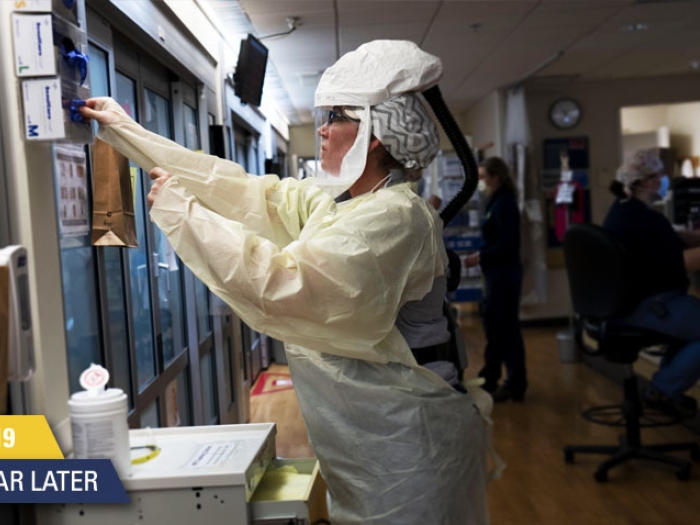Lessons from early peak state of Michigan could inform hospitals in other areas.
12:15 PM
Author |

Editor's note: Information on the COVID-19 crisis is constantly changing. For the latest numbers and updates, keep checking the CDC's website. For the most up-to-date information from Michigan Medicine, visit the hospital's Coronavirus (COVID-19) webpage.
Interested in a COVID-19 clinical trial? Health research is critical to ending the COVID-19 pandemic. Our researchers are hard at work to find vaccines and other ways to potentially prevent and treat the disease and need your help. Sign up to be considered for a clinical trial at Michigan Medicine.
Four months ago, Michigan glowed red on COVID-19 maps. Hundreds of patients packed hospital intensive care units in the southern part of the state, and hospitals statewide rapidly put strict new visitor policies in place to slow the spread of the new coronavirus. ICU teams had to scramble to connect with the families of critically ill and dying patients in new ways.
Now, a new study documents how 49 of those hospitals reacted, and how those efforts varied. It finds that virtually all hospitals put in place a "no visitors" blanket policy. But 59% of hospitals did allow some exceptions to this rule, most often for end-of-life visits, even at the pandemic's regional peak in April and early May.
Meanwhile, ICU teams that had spent years increasing the involvement of family members in care decisions and patient support turned to telephones and video chats, including on newly purchased tablets and critically ill patients' own smartphones.
The new findings may hold lessons for hospitals in current and future COVID-19 hotspots, as they try to strike a balance between safety and human connection. The study, performed by a University of Michigan team, appears in the American Journal of Respiratory and Critical Care Medicine.
The authors say that as the pandemic continues, more studies are needed on how visitation and communication changes affect patients, families and care team members – especially when patients can't communicate by themselves. They also point to the potential for restrictive visitor policies and virtual presence options to widen already stark health disparities.
Looking back
Lead author Thomas Valley, M.D., M.Sc., remembers all too well what those intense weeks of Michigan's peak were like, when the state had the fifth-highest ICU occupancy in the nation and hospitals stopped providing all but the most essential care.
He's an intensive care physician who was one of the first to work in a special COVID-19 ICU opened by Michigan Medicine, U-M's academic medical center.
SEE ALSO: Switching Gears at High Speed for Hospital COVID-19 Care
On his first day, he took care of a patient who was clearly about to die and whose daughter might have been able to come visit under Michigan Medicine's policy. But the daughter didn't want to risk exposure, so Valley found himself holding the patient's smartphone so the daughter could see her parent. She didn't want the patient to be without a family presence, even a virtual one, as they died.
"Talking with her was one of the most difficult things I've ever had to do as a physician, and I can't imagine what her family and so many others affected by this situation are going through," he says. "Conversations with families about critical care and the end of life are never easy, but it's so much harder to have them over the phone. For instance, I never thought about how important nonverbal cues are to these discussions."
This experience is what prompted him and colleagues, including U-M medical sociologist Katie Hauschildt, Ph.D., to perform the study by surveying ICU leaders in hospitals in urban, suburban and rural areas across the state by phone and computer in April and May.
More findings
While one hospital that answered the survey maintained a policy of allowing one visitor per ICU patient throughout, the rest of the state's hospitals cracked down hard on visitation. Nineteen of the hospitals surveyed were not allowing any visitors, without exception, at the time of the survey.
Of the 29 hospitals that allowed exceptions, 15 let visitors in to see patients at the end of life only. In another 13 hospitals, there were a few other exceptions besides end-of-life, including births, surgery and pediatric patients. One hospital considered each case individually.
Nine of the hospitals that allowed visitors only allowed one per patient, while 20 hospitals allowed more, often within a certain limit. A few hospitals required visitors to wear personal protective equipment or test negative for COVID-19 before coming to see their loved one.
Conversations with families about critical care and the end of life are never easy, but it's so much harder to have them over the phone.Thomas Valley, M.D., M.Sc.
More than 80% of the hospitals changed the way that ICU clinicians communicated with family members of critically ill patients. For the 17 hospitals that provided information about exactly what had changed, most said they were focusing on telephone – but six had started using video conferencing.
In addition, ICU leaders from two-thirds of all surveyed hospitals said they were encouraging video communication between patients and their family members using the patient's own tablets or smartphones.
As the pandemic continues, Valley and his colleagues continue to do research, even as Michigan's hospitalized COVID-19 cases remain much lower than in spring.
SEE ALSO: What Can Hospitals Do to Prepare for COVID-19 Cases?
"These rules were put in place for good reasons, to keep patients, family and health care workers safe in the face of a new virus," he says. "But now we have the opportunity to re-examine and see if these restrictions really kept us safe, to see how common infection is when family comes to visit, and to evaluate what the other impacts were."
If hospitals implement exceptions to their no-visitation rules, or set other conditions, it's also important to be transparent and even-handed about how they're applied to each patient. For instance, defining which patients are now at the 'end of life' is not clear cut. And implicit biases may affect how clinicians decide to offer or grant visitation options to some families over others.
As visitor restrictions continue, and hospitals ramp up care for patients who do not have COVID-19, the importance of virtual communications facilitated by hospital teams will continue, says Valley.
"In normal times, most of our serious conversations, except the most time-sensitive ones, would be in person, and we might wait for the visitors to arrive before initiating the communication," he says. "In our study, we found that many hospitals were proactively calling their ICU patients daily, just to give updates."
Valley notes that previous studies have shown that more than a third of family members of ICU patients experience depression, anxiety or post-traumatic stress symptoms – and the inability to be with their loved one in person may make that more likely, whether or not their loved one has COVID-19. The same may be true for care team members who are used to speaking with families in person, especially if they need to communicate to a family member they've never seen that their loved one is near the end of life and discuss their wishes.
The study was funded by the National Institutes of Health (HL140165). Valley is an assistant professor of internal medicine at the U-M Medical School, and a member of the U-M Institute for Healthcare Policy and Innovation and the Center for Bioethics and Social Sciences in Medicine. Hauschildt, who recently completed her doctorate in the U-M Department of Sociology, is now a postdoctoral fellow in the VA Center for Clinical Management Research. Other authors are Amanda Schutz, PhD, Max T. Nagle, MD, MPH, Lewis J. Miles, Kyra Lipman, Scott W. Ketcham, MD, Madison Kent, Clarice E. Hibbard, BAS and Emily A. Harlan, MD, MA.
Paper cited: "Changes to Visitation Policies and Communication Practices in Michigan Intensive Care Units During the COVID-19 Pandemic," American Journal of Respiratory and Critical Care Medicine. DOI: 10.1164/rccm.202005-1706LE

Explore a variety of healthcare news & stories by visiting the Health Lab home page for more articles.

Department of Communication at Michigan Medicine
Want top health & research news weekly? Sign up for Health Lab’s newsletters today!





